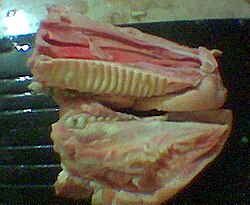Loading AI tools
From Wikipedia, the free encyclopedia
The secondary palate is an anatomical structure that divides the nasal cavity from the oral cavity in many vertebrates.
| Secondary palate | |
|---|---|
 A sagittal section of a pig's (Sus sp.) snout showing the secondary palate with pronounced palatine raphe. | |
| Details | |
| Identifiers | |
| Latin | Palatum secundarium, palatum definitivum |
| TE | palate_by_E5.4.1.1.4.0.5 E5.4.1.1.4.0.5 |
| Anatomical terminology | |
In human embryology, it refers to that portion of the hard palate that is formed by the growth of the two palatine shelves medially and their mutual fusion in the midline. It forms the majority of the adult palate and meets the primary palate at the incisive foramen.
Secondary palate development begins in the sixth week of pregnancy and can lead to cleft palate when development goes awry.
There are three major mechanisms known to cause this failure:
The secondary palate is thought to have a significant role in the development of some warm-blooded animals. The separation of the mouth from the nasal cavity also allowed chewing and breathing to occur at the same time. Early creatures with secondary palates include crocodilians (who are cold-blooded), and cynodonts and a few others among the therapsids, known from the fossil record in the mid-Permian. Mammals inherited our hard palates from the cynodonts.
Seamless Wikipedia browsing. On steroids.
Every time you click a link to Wikipedia, Wiktionary or Wikiquote in your browser's search results, it will show the modern Wikiwand interface.
Wikiwand extension is a five stars, simple, with minimum permission required to keep your browsing private, safe and transparent.